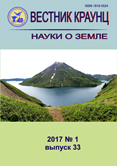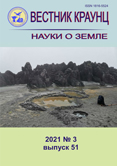Аннотация
Трансформные разломы широко распространены в пределах Атлантического океана. Их рельеф определяется множеством факторов, связанных преимущественно с особенностями глубинного строения литосферы и региональной геодинамики. Степень их влияния меняется при переходе от одной морфотектонической провинции Атлантического океана к другой. Различия проявляются в морфологии основных элементов трансформного разлома и соотношении их морфометрических параметров с длиной активной части, что было показано ранее аналоговым моделированием. Выявлена зависимость между глубиной трансформной долины и величиной смещения оси Срединно-Атлантического хребта по трансформному разлому. Колебания значений морфометрических параметров интерпретированы как следствие разной продолжительности развития разломов, а также разной степени влияния второстепенных факторов в пределах каждой из провинции. На основании анализа батиметрических данных по трансформным разломам Атлантики были выявлены пять основных групп рельефообразующих факторов, в пределах которых была определена значимость каждого из них. Предполагается, что выявленные зависимости сохраняются в отношении трансформных разломов в других океанах.Библиографические ссылки
Грохольский А.Л., Дубинин Е.П. Структурообразование в рифтовых зонах и поперечных смещениях осей спрединга по результатам физического моделирования // Физика Земли. 2010. № 5. С. 49–55 [Grokholsky A.L., Dubinin E.P. Structure Formation in the Rift Zones and in Transvers Offset of the Spreading Axes: Results of Physical Modeling // Izvestiya, Physics of the Solid Earth. 2010. V. 46. P. 412–18. https://doi.org/10.1134/S106935131005006X].
Дубинин Е.П. Трансформные разломы океанической литосферы. М.: Изд-воМГУ, 1987. 182 с. [Dubinin E.P. Transform faults of the oceanic lithosphere. Moscow.: MSU ed., 1987. 182 p. (in Russian)].
Дубинин Е.П., Грохольский А.Л., Кохан А.В., Свешников А.А. Термическое и реологическое состояние литосферы и особенности структурообразования в рифтовой зоне хребта Рейкьянес (по результатам численного и экспериментального моделирования). Физика Земли. 2011. № 7. С. 30–43 [Dubinin E.P., Grokholsky A.L., Kokhan A.V., Sveshnikov A.A. Thermal and Rheological State of the Lithosphere and Specific Features of Structuring in the Rift Zone of the Reykjanes Ridge (from the Results of Numerical and Experimental Modeling) // Izvestiya, Physics of the Solid Earth. 2011. V. 47. № 7. P. 586–599. https://doi.org/10.1134/S1069351311060036].
Дубинин Е.П., Ушаков С.А. Океаническийрифтогенез. М.: ГЕОС, 2001. 293 с. [Dubinin E.P., Ushakov S.A. Oceanic riftogenesis. Moscow: GEOS, 2001. 293 p. (in Russian)]
Кохан А.В., Дубинин Е.П., Грохольский А.Л. Геодинамические особенности структурообразования в спрединговых хребтах Арктики и Полярной Атлантики // Вестник КРАУНЦ. Науки о Земле. 2012. № 1. Вып. № 19. С. 59–77 [Kokhan A.V., Dubinin E.P., Grokholsky A.L. Geodynamic features of structure forming in spreading ridges of Arctic and Polar Atlantic // Vestnik KRAUNTs. Nauki o Zemle. 2012. № 2 (19). P. 59–77 (in.Russian)].
Мазарович А.О. Геологическое строение Центральной Атлантики: Разломы, вулканические сооружения и деформации океанического дна. М.: Научныймир, 2000. 176 с. [Mazarovich A.O. Geological structure of Central Atlantic: Fracture zones, volcanic edifices and deformations of the ocean floor. Moscow: Scientific world, 2000. 176 p. (in Russian)].
Мирлин Е.Г., Сущевская Н.М. Тектономагматическая сегментация срединно-океанических хребтов, мантийный апвеллинг, асимметрия Земли // Геотектоника. 1992. № 2. С. 3–22 [Mirlin E.G., Sushchevskaya N.M. Tectonomagmatic segmentation of mid-oceanic ridges, mantle upwelling, Earth asymmetry // Geotektonika. 1992. Iss. 2. P. 3–22 (in Russian)].
Мировой океан. Т. I. Геология и тектоника океана. Катастрофические явления в океане / Под ред. Лобковского Л.И. М.: Научный Мир, 2013. 644 с. [The World Ocean. V. I. Ocean geology and tectonics. Oceanic catastrophic phenomena.Moscow: Scientificworld, 2013. 644 p. (in Russian)].
Пейве А.А. Структурно-вещественные неоднородности, магматизм и геодинамические особенности Атлантического океана. М.: Научный мир, 2002. 278 с. [Peyve A.A. Structural-compositional heterogeneities, magmatism and geodynamic features of the Atlantic ocean. Moscow: Scientific world, 2002. 278 p. (in Russian)].
Пущаровский Ю.М., Пейве А.А., Сколотнев С.Г. и др. Тектоника и железо-марганцевая металлогения Атлантического океана. М.: ГЕОС, 2011. 292 с. [Pushcharovskiy Yu.M., Peyve A.A., Skolotnev S.G. et al. Tetonocs and iron-manganese metallogenesis of the Atlantic ocean. Moscow: GEOS, 2011. 292 p. (in Russian)].
Сколотнев С.Г. Регулярные и региональные вариации состава и строения океанической коры и структуры океанического дна Центральной, Экваториальной и Южной Атлантики: Дисс. докт. геол.-мин. наук. М, 2015. 568 с. [Skolotnev S.G. Regular and regional variations of composition and structure of oceanic crust and structure of the ocean floor of Central, Equatorial and South Atlantic: diss. of doct. of geol.-min. scien. Moscow, 2015. 568 p. (in Russian)].
Соколов С.Ю. Особенности тектоники Срединно-Атлантического хребта по данным корреляции поверхностных параметров с геодинамическим состоянием верхней мантии // Вестник КРАУНЦ. Науки о Земле. 2016. № 4. Вып. 32. С. 88–105 [Sokolov S.Yu. Tectonic peculiarities of the Mid-Atlantic ridge based on data on correlation between surface parameters and geodynamic state of the upper mantle // Vestnik KRAUNTs. Nauki o Zemle. 2016. № 4(32). P. 88–105 (in Russian)].
Соколов С.Ю. Тектоника и геодинамика Экваториального сегмента Атлантики. (Труды ГИН РАН: вып. 618). М.: Научный мир, 2018. 269 с. [Sokolov S.Yu. Tectonics and Geodynamics of the Atlantic Equatorial Segment. (Transactions of GIN RAS; V. 530) Moscow: Scientific World, 2018. 269 p. (in Russian)].
Соколов С.Ю., Чамов Н.П., Хуторской М.Д., Силантьев С.А. Индикаторы интенсивности геодинамических процессов вдоль Атлантико-Арктической рифтовой системы. 2020. Т. 11. № 2. С. 302–319. https://doi.org/10.5800/GT-2020-11-2-0476 [Sokolov S.Yu., Chamov N.P., Khutorskoy M.D., Silantiev S.A. Intensity indicators of geodynamic processes along the Atlantic-Arctic rift system // Geodynamics & Tectonophysics. 2020. V. 11. Iss. 2. P. 302–319 (in Russian)].
Хуторской М.Д., Поляк Б.Г. Особенности теплового потока в трансформных разломах Северной Атлантики и Юго-Восточной Пацифики // Геотектоника. 2017. № 2. С. 55–66 https://doi.org/10.7868/S0016853X17010027 [Khutorskoi M.D., Polyak B.G. Special Features of Heat Flows in Transform Faultsof the North Atlantic and Southeast Pacific // Geotectonics. 2017. V. 51. Iss. 2. P. 152–162. https://doi.org/10.1134/S0016852117010022].
Ammann N., Liao J., Gerya T., Ball P. Oblique continental rifting and long transform fault formation based on 3D thermomechanical numerical modeling // Tectonophysics. 2018. V. 746. P. 106-120. https://doi.org/10.1016/j.tecto.2017.08.015
Ben-Avraham Z., Hartnady C.J.H., Kitchin K.A. Structure and tectonics of the Agulhas-Falkland fracture zone // Tectonophysics. 1997. V. 282. Iss. 1–4. P. 83–98. https://doi.org/10.1016/S0040-1951(97)00213-8
Bonatti E., Brunelli D., Buck W.R. et al. Flexural uplift of a lithospheric slab near the Vema transform (Central Atlantic): Timing and mechanisms // Earth and Planetary Science Letters. 2005. V. 240. № 3. P. 642–655. https://doi.org/10.1016/j.epsl.2005.10.010
Bonvalot S., Balmino G., Briais A. et al. WorldGravityMap / CommissionfortheGeologicalMapoftheWorld. Eds. BGI-CGMW-CNES-IRD, Paris. 2012.
Dauteuil O., Bourgeois O., Mauduit T. Lithosphere strength controls oceanic transform zone structure: Insights from analogue models // Geophysical Journal International. 2002. V. 150. P. 706–714. https://doi.org/10.1046/j.1365-246X.2002.01736.x
Dean S.L., Sawyer D.S., Morgan J.K. Galicia Bank ocean–continent transition zone: New seismic reflection constraints // Earth and Planetary Science Letters. 2015. V. 413. P. 197–207. https://doi.org/10.1016/j.epsl.2014.12.045
Detrick R.S., Purdy G.M. The crustal structure of the Kane fracture zone from seismic refraction studies // JGR. 1980. V. 85(B7). P. 3759–3777. https://doi.org/10.1029/JB085iB07p03759
Dick H.J.B., Tivey M.A., Tucholke B.E. Plutonic foundation of a slow–spreading ridge segment: Oceanic core complex at Kane Megamullion, 23°30'N, 45°20'W // Geochemistry, Geophysics, Geosystems. 2008. V. 9. Iss. 5. P. 1–44. https://doi.org/10.1029/2007GC001645
Divins D.L. Total Sediment Thickness of the World’s Oceans & Marginal Seas / NOAA National Geophysical Data Center, Boulder, CO. 2003.
Earthquake activity data / The Geologic Hazards Science Center. URL: https://www.usgs.gov.
GEBCO_2019. URL: https://www.gebco.net/data_and_products/gridded_bathymetry_data/gebco_2019/gebco_2019_info.html
Hensen S., Duarte J.C., Vanucchi P. et al. Marine Transform Faults and Fracture Zones: A Joint Perspective Integrating Seismicity, Fluid Flow and Life // Frontiers in Earth Science. 2019. V. 7. Article 39. 29 P. https://doi.org/10.3389/feart.2019.00039
Karson J.A., Dick H.J.B. Tectonics of ridge – transform intersection at the Kane fracture zone // Marine Geophysical Research. 1983. V. 6. P. 51–98. https://doi.org/10.1007/BF00300398
Morozov E.G., Demidov A.N., Tarakanov R.Y., Zenk W. Abyssal Channels in the Atlantic Ocean / Dordrecht, Heidelberg, London, New York: Springer, 2010. 288 p. https://doi.org/10.1007/978-90-481-9358-5
Ryan W.B.F., Carbotte S.M., Coplan J.O. et al. Global Multi-Resolution Topography synthesis // Geochemistry, Geophysics, Geosystems. 2009. V. 10. P. 23–32. https://doi.org/10.1029/2008GC002332
Sandwell D.T., Smith W.H.F. Global marine gravity from retracked Geosat and ERS-1 altimetry: Ridge Segmentation versus spreading rate // JGR. 2009. V. 114. P. 14–28. https://doi.org/10.1029/2008JB006008
Tentler T., Acocella V. How does the initial configuration of oceanic ridge segments affect their interaction? Insights from analogue models // JGR. V. 115. P. 25–41. https://doi.org/10.1029/2008JB006269
Thibaud R., Gente P., Maia M. A systematic analysis of the Mid-Atlantic Ridge morphology and gravity between 15°N and 40°N: Constraints of the thermal structure // JGR. 1998. V. 103(B10). P. 24223–24243. https://doi.org/10.1029/97JB02934
Whitmarsh R.B., Miles P.R. Models of the development of the West Iberia rifted continental margin at 40°30’ N deduced from surface and deep-tow magnetic anomalies // JGR. 1995. V. 100(B3). P. 3789–3806. https://doi.org/10.1029/94JB02877
Wilson R.C.L., Manatschal G., Wise, S., Rifting along non-volcanic passive margins: stratigraphic and seismic evidence from the Mesozoic successions of the Alps and western Iberia. Geol. Soc. (Lond.), 2000. Spec. Publ. 187. P. 429–452.

Контент доступен под лицензией Creative Commons Attribution-NonCommercial 4.0 International License.

